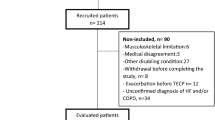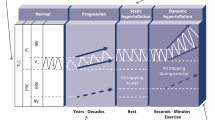Abstract
Objectives: To investigate total daily energy expenditure in chronic obstructive pulmonary disease (COPD) patients during a rehabilitation programme.
Design: Observational study involving a case and a control group.
Subjects: Ten COPD patients (six with body mass index (BMI) <18.5 kg/m2 and four with BMI >18.5 kg/m2) were evaluated for their energy expenditure profile. Four additional healthy age-matched volunteers were also included for methodology evaluation.
Interventions: Measurements of total daily energy expenditure (TEE), resting energy expenditure (REE) and diet-induced thermogenesis (DIT) and energy intake were undertaken by indirect calorimetry and bicarbonate–urea methods and dietary records.
Results: REE in COPD patients was not significantly different from that predicted by the Harris–Benedict equation. Before the exercise day the mean TEE was 1508 kcal/day and physical activity level (PAL as calculated by TEE/REE) was 1.52. On the exercise day the TEE increased to 1568 kcal/day and PAL was 1.60, but neither of these changes were significant. The energy cost of increased physical activity during rehabilitation exercise was estimated to be 191 kcal/day. No significant change was found in DIT between the two patient groups. However, overall energy balances were found to be negative (−363 kcal/day).
Conclusion: The rehabilitation programme did not cause a significant energy demand in COPD patients. TEE in COPD patients was not greater than in free-living healthy subjects. Patients, who were underweight, did not have a higher TEE than patients with normal weight. This suggested that malnutrition in COPD patients was not due to an increased energy expenditure. On the other hand, a significant negative energy balance due to insufficient energy intake was found in seven out of 10 patients.
Sponsorship: The project was inpart supported by the Bristol Myers Squibb Unrestricted Nutrition Grant.
This is a preview of subscription content, access via your institution
Access options
Subscribe to this journal
Receive 12 print issues and online access
$259.00 per year
only $21.58 per issue
Buy this article
- Purchase on Springer Link
- Instant access to full article PDF
Prices may be subject to local taxes which are calculated during checkout
Similar content being viewed by others
References
Ainsworth BE, Haskell WL, Leon AS, Jacobs DR Jr., Montoye HJ, Sallis JF, Paffenbarger RS Jr . 1993 Compendium of physical activities: classification of energy costs of human physical activities Med. Sci. Sports Exerc 25: 71–80
Baarends EM, Schols AM, Pannemans DL, Westerterp KR, Wouters EF . 1997a Total free living energy expenditure in patients with severe chronic obstructive pulmonary disease Am. J. Respir. Crit. Care Med 155: 549–554
Baarends EM, Schols AM, Westerterp KR, Wouters EF . 1997b Total daily energy expenditure relative to resting energy expenditure in clinically stable patients with COPD Thorax 52: 780–785
Cohen J . 1988 Statistical Statistical Power Analysis for the Behavioral Sciences, 2nd edn. New Jersey: Laurence Erlbaum
Creutzberg EC, Schols AM, Bothmer-Quaedvlieg FC, Wouters EF . 1998 Prevalence of an elevated resting energy expenditure in patients with chronic obstructive pulmonary disease in relation to body composition and lung function Eur. J. Clin. Nutr 52: 396–401
Department of Health . 1991 Dietary Reference Values for Food, Energy and Nutrients for the United Kingdom London: HMSO
Dore MF, Laaban JP, Orvoen-Frija E, Kouchakji B, Joubert M, Rochemaure J . 1997 Role of the thermic effect of food in malnutrition of patients with chronic obstructive pulmonary disease Am. J. Respir. Crit. Care Med 155: 1535–1540
Elia M . 1991 Energy equivalents of CO2 and their importance in assessing energy expenditure when using tracer techniques Am. J. Physiol 260(1 Pt 1): E75–88
Elia M . 1995 Changing concepts of nutrient requirements in disease: implications for artificial nutritional support Lancet 345: 1279–1284
Elia M . 1997 Tissue distribution and energetics in weight loss and undernutrition. In Physiology, Stress and Malnutrition: Functional Correlates and Nutritional Intervention, ed. JM Kinney & HN Tucker 383–412. New York: Lipcott-Raven.
Elia M, Jebb SA . 1992 Changing concepts of energy requirements in critically ill patients Curr. Med. Lit. in Clin. Nutr 1: 35–38
Elia M, Livesey G . 1992 Energy expenditure and fuel selection in biological systems: the theory and practice of calculations based on indirect calorimetry and tracer methods World Rev. Nutr. Diet 70: 68–131
Elia M, Jones MG, Jennings G, Poppitt SD, Fuller NJ, Murgatroyd PR, Jebb SA . 1995 Estimating energy expenditure from specific activity of urine urea during lengthy subcutaneous NaH14CO3 infusion Am. J. Physiol 269(1 Pt 1): E172–182
Elia M, Ritz P, Stubbs RJ . 2000 Energy expenditure in the elderly Eur. J. Clin. Nutr 54 Suppl 3: S1–S12
Folgering H, Rooyackers J . 1998 Pulmonary rehabilitation in chronic obstructive pulmonary disease Eur. Respir. J 11: 520–523
Fuller NJ, Sawyer MB, Coward WA, Paxton P, Elia M . 1996 Components of total energy expenditure in free-living elderly men (over 75 y of age): measurement, predictability and relationship to quality-of-life indices Br. J. Nutr 75: 161–173
Gibney E, Elia M, Jebb SA, Murgatroyd P, Jennings G . 1997 Total energy expenditure in patients with small-cell lung cancer: results of a validated study using the bicarbonate-urea method Metabolism 46: 1412–1417
Gray-Donald K, Gibbons L, Shapiro SH, Macklem PT, Martin JG . 1996 Nutritional status and mortality in chronic obstructive pulmonary disease Am. J. Respir. Crit. Care Med 153: 961–966
Green JH, Muers MF . 1991 The thermic effect of food in underweight patients with emphysematous chronic obstructive pulmonary disease Eur. Respir. J 4: 813–819
Hugli O, Frascarolo P, Schutz Y, Jequier E, Leuenberger P, Fitting JW . 1993 Diet-induced thermogenesis in chronic obstructive pulmonary disease Am. Rev. Respir. Dis 148: 6 Pt 1: 1479–1483
Hugli O, Schutz Y, Fitting JW . 1996 The daily energy expenditure in stable chronic obstructive pulmonary disease Am. J. Respir. Crit. Care Med 153: 294–300
Landbo C, Prescott E, Lange P, Vestbo J, Almdal TP . 1999 Prognostic value of nutritional status in chronic obstructive pulmonary disease Am. J. Respir. Crit. Care Med 160: 1856–1861
Leijssen DP, Elia M . 1996 Recovery of 13CO2 and 14CO2 in human bicarbonate studies: a critical review with original data Clin. Sci. (Colch.) 91: 665–677
Paton NI, Elia M, Jebb SA, Jennings G, Macallan DC, Griffin GE . 1996 Total energy expenditure and physical activity measured with the bicarbonate-urea method in patients with human immunodeficiency virus infection Clin. Sci. (Colch) 91: 241–245
Ryan CF, Road JD, Buckley PA, Ross C, Whittaker JS . 1993 Energy balance in stable malnourished patients with chronic obstructive pulmonary disease Chest 103: 1038–1044
Schols AM, Soeters PB, Dingemans AM, Mostert R, Frantzen PJ, Wouters EF . 1993 Prevalence and characteristics of nutritional depletion in patients with stable COPD eligible for pulmonary rehabilitation Am. Rev. Respir. Dis 147: 1151–1156
Stratton RJ, Elia M . 1999 A critical systematic analysis of the use of oral nutritional supplements in the community Clin. Nutr 18 Suppl 2: 29–84
Tiep BL . 1997 Disease management of COPD with pulmonary rehabilitation Chest 112: 1630–1656
Wilson DO, Donahoe M, Rogers RM, Pennock BE . 1990 Metabolic rate and weight loss in chronic obstructive lung disease J. Parenter. Enteral Nutr 14: 7–11
Woo J, Ho SC, Donnan SP, Swaminathan R . 1988 Nutritional status of healthy, active, Chinese elderly Br. J. Nutr 60: 21–28
Author information
Authors and Affiliations
Corresponding author
Rights and permissions
About this article
Cite this article
Tang, N., Chung, M., Elia, M. et al. Total daily energy expenditure in wasted chronic obstructive pulmonary disease patients. Eur J Clin Nutr 56, 282–287 (2002). https://doi.org/10.1038/sj.ejcn.1601299
Received:
Revised:
Accepted:
Published:
Issue Date:
DOI: https://doi.org/10.1038/sj.ejcn.1601299
Keywords
This article is cited by
-
Nutritional depletion and its relationship to respiratory impairment in patients with chronic respiratory failure due to COPD or restrictive thoracic diseases
European Journal of Clinical Nutrition (2008)
-
A practical approach to estimate resting energy expenditure in frail elderly people
The Journal of nutrition, health and aging (2008)
-
Physiological aspects of energy metabolism and gastrointestinal effects of carbohydrates
European Journal of Clinical Nutrition (2007)
-
Energy expenditure in underweight chronic obstructive pulmonary disease patients before and during a physiotherapy programme
European Journal of Clinical Nutrition (2006)
-
Low staffing level is associated with malnutrition in long-term residential care homes
European Journal of Clinical Nutrition (2005)



